Capturing Geneva: The Ultimate Photographer’s Journey Through the City of Peace
Geneva: A Photographer’s Dream
Geneva offers an exceptional backdrop for photographers, where centuries of rich history coexist harmoniously with contemporary diplomacy, and the stunning natural landscape highlights human innovation. Join me as I unveil how this extraordinary city unfolds through the artist’s lens, particularly when showcased in the classic beauty of black and white photography.
Exploring Geneva’s Visual Poetry
The city’s character presents itself through various unique yet intertwined layers. At its center lies the iconic Jet d’Eau, soaring 140 meters into the air. This astonishing fountain transcends its role as merely a landmark – it offers photographers a fresh perspective throughout the day. During the early hours, it captures the initial rays of sunlight, casting striking contrasts against the morning sky. As dusk settles, it morphs into a silhouette against the vibrant sunset, providing endless creative opportunities for interpretation.
The Léman Lakefront, especially along the Quai du Mont-Blanc, serves as a perfect lesson in composition. Here, the interaction among water, mountains, and sky forms natural leading lines and mesmerizing reflections. The key to encapsulating this area’s essence lies in timing – the golden hours of dawn and dusk envelop the scene in subtle gradients that vividly translate into monochrome.
The Historical Heart
Geneva’s Old Town (Vieille Ville) provides essential insights into architectural photography. Its cobblestoned streets and historical edifices illustrate the interaction of light and shadow with texture. When snapping photos here, pay close attention to how the morning light filters through narrow alleys, creating dramatic shadows that enhance the depth of your images. The Cathedral St. Pierre, with its Gothic allure, becomes a study of detail and contrast, especially when captured with an eye for its intricate stone craftsmanship.
Modern Geneva and Global Spirit
The city’s prominence as a global diplomatic hub presents distinctive photographic chances. The Palace of Nations, housing the European headquarters of the UN, delivers insights on symmetry and scale. When photographing this grand structure, think about how its synchronized rows of flags can create rhythm within your composition. Early morning or late afternoon light can work wonders here, as the shadows introduce depth to the building’s formidable facade.
The CERN Globe of Science and Innovation poses a unique challenge – capturing modern architecture in a way that expresses both its scientific intent and aesthetic form. Its spherical design lends itself to creative experiments with geometric compositions that shine in black and white.
Natural Elements and Urban Parks
Geneva’s parks offer endless opportunities for nature photography within an urban setting. The Parc des Bastions, home to the renowned Reformation Wall, exemplifies how historical monuments can be beautifully framed by nature’s bounty. The shifting seasons in Parc La Grange and Parc des Eaux-Vives remind us of the virtue of patience in photography – each visit unveils unique lighting conditions and organic compositions.
The Art of Street Photography
Street photography in Geneva calls for an understanding of the city’s distinct rhythm. The Bains des Pâquis provides an ideal scene for capturing local life, especially during the early morning hours when residents assemble for their daily swim. The secret here lies in observing and foreseeing moments, allowing the scene to unfold naturally before your lens.
Technical Approach
Utilizing a Leica M11 Monochrome offers significant advantages when photographing Geneva. The camera’s remarkable dynamic range captures both the bright highlights of the Jet d’Eau and the soft shadows within Old Town’s ancient corridors. When approaching any scene, keep in mind:
- The interplay of light and shadow, critical in black and white photography.
- The city’s textures, from weathered stone to sleek glass.
- The compositional elements that narrate Geneva’s tale, from architectural nuances to human interactions.
Personal Connection
My photographic journey has taken me from Ecuador to Pakistan, from Senegal to India, and from Namibia to China. Yet, time and again, Geneva reveals new angles and challenges. As Osho Rajneesh astutely remarked, “unless you look for something you cannot see it.” This philosophy captures the essence of photographing Geneva – each day brims with fresh opportunities to uncover hidden gems within this multifaceted city.
Conclusion
Geneva’s allure lies not merely in its iconic landmarks but in the subtle moments that unveil themselves to the astute observer. Whether you’re documenting the expansive beauty of the lakefront or the intricate details of daily life, remember that every photograph contributes to the larger narrative of this extraordinary city. Through your lens, you have the power to participate in the continuous visual story of a place where global diplomacy, breathtaking landscapes, and human achievement elegantly converge.
About the Photographer
Pierre Michel Virot, Media Director at AIFOD, is a Geneva-based photographer whose works have graced esteemed publications like The New York Times, Sports Illustrated, and The Financial Times. Throughout his career, he has documented significant moments for United Nations agencies and governments worldwide, from Ecuador to China, capturing the intersection of human advancement and technological progress through his distinctive black and white photography.
In his role as AIFOD’s Media Director, Virot leverages his vast international experience and dedication to visual storytelling to craft compelling narratives about AI’s influence in developing countries. Guided by the principle, “unless you look for something you cannot see it,” he unveils the subtle links between technological innovation and human experience, making him uniquely positioned to spearhead AIFOD’s media initiatives.






